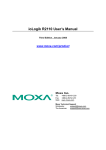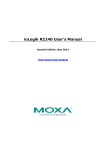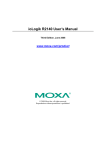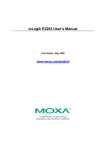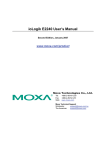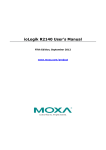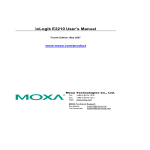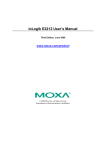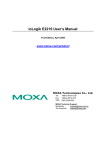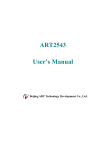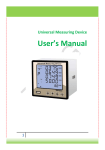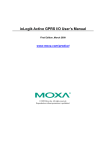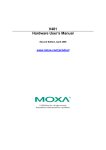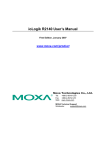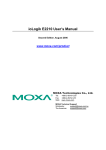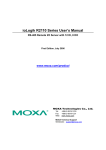Download ioLogik R2110 User`s Manual
Transcript
ioLogik R2110 User’s Manual Fifth Edition, May 2012 www.moxa.com/product © 2012 Moxa Inc. All rights reserved. ioLogik R2110 User’s Manual The software described in this manual is furnished under a license agreement and may be used only in accordance with the terms of that agreement. Copyright Notice © 2012 Moxa Inc. All rights reserved. Trademarks The MOXA logo is a registered trademark of Moxa Inc. All other trademarks or registered marks in this manual belong to their respective manufacturers. Disclaimer Information in this document is subject to change without notice and does not represent a commitment on the part of Moxa. Moxa provides this document as is, without warranty of any kind, either expressed or implied, including, but not limited to, its particular purpose. Moxa reserves the right to make improvements and/or changes to this manual, or to the products and/or the programs described in this manual, at any time. Information provided in this manual is intended to be accurate and reliable. However, Moxa assumes no responsibility for its use, or for any infringements on the rights of third parties that may result from its use. This product might include unintentional technical or typographical errors. Changes are periodically made to the information herein to correct such errors, and these changes are incorporated into new editions of the publication. Technical Support Contact Information www.moxa.com/support Moxa Americas Moxa China (Shanghai office) Toll-free: 1-888-669-2872 Toll-free: 800-820-5036 Tel: +1-714-528-6777 Tel: +86-21-5258-9955 Fax: +1-714-528-6778 Fax: +86-21-5258-5505 Moxa Europe Moxa Asia-Pacific Tel: +49-89-3 70 03 99-0 Tel: +886-2-8919-1230 Fax: +49-89-3 70 03 99-99 Fax: +886-2-8919-1231 Moxa India Tel: +91-80-4172-9088 Fax: +91-80-4132-1045 Table of Contents 1. Introduction ...................................................................................................................................... 1-1 Overview ........................................................................................................................................... 1-2 Optional Liquid Crystal Display Module (LCM) ......................................................................................... 1-2 Product Features ................................................................................................................................ 1-2 Packing List........................................................................................................................................ 1-3 Specifications ..................................................................................................................................... 1-3 Physical Dimensions ............................................................................................................................ 1-4 Without LCM ............................................................................................................................... 1-4 With Optional LCM ....................................................................................................................... 1-5 LED Indicators .................................................................................................................................... 1-5 Hardware Reference ............................................................................................................................ 1-6 Pin Assignments ................................................................................................................................. 1-6 System Bus ................................................................................................................................ 1-6 TB1 and TB2 (Power Input & RS-485 Connector) ............................................................................. 1-6 TB3 (Digital Input and Output Terminal) ......................................................................................... 1-7 2. Initial Setup ...................................................................................................................................... 2-1 Hardware Installation .......................................................................................................................... 2-2 Connecting the Power .................................................................................................................. 2-2 Grounding the ioLogik R2110 ........................................................................................................ 2-2 Connecting to Digital Sensors and Devices ..................................................................................... 2-2 Setting the RS-485 Baudrate ........................................................................................................ 2-3 Modbus/RTU Devices ................................................................................................................... 2-3 Software Installation ........................................................................................................................... 2-4 3. Using ioAdmin ................................................................................................................................... 3-1 Introduction to ioAdmin ....................................................................................................................... 3-2 Features of ioAdmin ............................................................................................................................ 3-2 Searching for the Unit .................................................................................................................. 3-4 ioAdmin Main Screen........................................................................................................................... 3-6 Main Screen Overview.................................................................................................................. 3-6 Wiring Guide ............................................................................................................................... 3-7 Menu Items ....................................................................................................................................... 3-8 File ............................................................................................................................................ 3-8 System ...................................................................................................................................... 3-8 Sort ........................................................................................................................................... 3-9 Help .......................................................................................................................................... 3-9 Quick Links ................................................................................................................................. 3-9 Main Window.................................................................................................................................... 3-10 I/O Configuration Tab (General) .................................................................................................. 3-10 Server Info Tab ......................................................................................................................... 3-10 Server Settings Tab (General) ..................................................................................................... 3-11 ioAdmin Administrator Functions ........................................................................................................ 3-11 I/O Configuration Tab (Administrator) .......................................................................................... 3-12 Server Settings Tab (Administrator) ............................................................................................. 3-14 Firmware Update Tab ................................................................................................................. 3-15 Watchdog Tab ........................................................................................................................... 3-15 Server Context Menu ................................................................................................................. 3-16 4. Cascading with Other I/O Servers .................................................................................................... 4-1 Introduction ....................................................................................................................................... 4-2 Cascading System Bus ........................................................................................................................ 4-2 Hardware Installation .......................................................................................................................... 4-2 Using ioAdmin with Cascaded I/O Servers .............................................................................................. 4-3 Adding One I/O Server ................................................................................................................. 4-3 Adding Two or More I/O Servers .................................................................................................... 4-4 Removing Cascaded I/O Servers ................................................................................................... 4-5 Limitations ......................................................................................................................................... 4-5 A. Liquid Crystal Display Module (LCM) ................................................................................................. A-1 B. Modbus/RTU Address Mappings ........................................................................................................ B-1 R2110 Modbus Mapping ....................................................................................................................... B-1 0xxxx Read/Write Coils (Functions 1, 5, 15) ...................................................................................B-1 1xxxx Read Only Coils (Function 2) ...............................................................................................B-7 3xxxx Read Only Registers (Function 4) .........................................................................................B-8 4xxxx Read/Write Registers (Functions 3, 6, 16) .............................................................................B-8 Function 8 ................................................................................................................................ B-10 C. Factory Default Settings .................................................................................................................... C-1 D. Pinouts and Cable Wiring .................................................................................................................. D-1 Pin Assignment of Terminal Blocks ....................................................................................................... Power (TB1) and RS-485 (TB2) .................................................................................................... I/O (TB3) .................................................................................................................................. Digital Input Wiring ............................................................................................................................ Structure................................................................................................................................... Dry Contact ............................................................................................................................... Wet Contact............................................................................................................................... Example .................................................................................................................................... Digital Output.................................................................................................................................... Structure................................................................................................................................... Output Channel .......................................................................................................................... D-1 D-1 D-1 D-1 D-1 D-2 D-2 D-2 D-3 D-3 D-3 1 1. Introduction The ioLogik R2110 is a stand-alone remote digital I/O server that can connect sensors for automation applications over an RS-485 connection. The following topics are covered in this chapter: Overview Optional Liquid Crystal Display Module (LCM) Product Features Packing List Specifications Physical Dimensions Without LCM With Optional LCM LED Indicators Hardware Reference Pin Assignments System Bus TB1 and TB2 (Power Input & RS-485 Connector) TB3 (Digital Input and Output Terminal) ioLogik R2110 Introduction Overview (shown with and without optional LCM) The ioLogik R2110 is a member of the R2000 series of remote I/O servers, which are designed to link sensors, transmitters, transducers, and valves to an RS-485 network. The ioLogik R2110 can be attached to an ioLogik E2000 series server so I/O points can be accessed from within a single IP environment. One ioLogik E2000 series server can connect up to 31 ioLogik R2000 series servers. Optional Liquid Crystal Display Module (LCM) The ioLogik R2110 supports an optional hot-pluggable liquid crystal display module (LCM) for field management and configuration. The module can be used for on-site configuration or monitoring, and works with any ioLogik E or R series product. Product Features • 12 channels of 24 VDC digital input (DI) with event counter mode and software selectable filtering time • 8 channels of 24 VDC digital output (DO) with pulse output mode and software selectable pulse width • Multi-functional I/O supporting DI, event counter, DO, and pulse output • Supports Modbus/RTU for control by SCADA software, including Wonderware InTouch and GE Intellution iFix32 • Optional LCD module for status display and configuration • Remote firmware updates via RS-485 • Monitoring and configuration with ioAdmin Windows utility • Hardware detection over RS-485 with ioAdmin • MXIO DLL library for I/O status over RS-485 • Built-in watchdog timer with configurable safe I/O channel settings • Configurable power-on status for output channels • OHS compliant 1-2 ioLogik R2110 Introduction Packing List The ioLogik R2110 is shipped with the following items: Standard Accessories • ioLogik R2110 RS-485 I/O server • Document & Software CD Optional Accessories • LDP1602 ioLogik liquid crystal display module (LCM) NOTE: Please notify your sales representative if any of the above items are missing or damaged. Specifications Serial Interface 2-wire RS-485 with Data+, Data-, GND Serial Line Protection 15 KV ESD for all signals Serial Communication Parameters Baudrates 1200 to 115200 bps Direction Control Built-in ADDCTM Parity None Data Bits 8 Stop Bits 1 Flow Control None Speed 1200 to 115200 bps Protocol Modbus/RTU Digital Input Channels 12 fixed points, source type DI COM Power Input 24 VDC nominal, up to 36 VDC Modes DI or Event Counter (up to 50 Hz) Dry contact Logic 0: close to GND Logic 1: open Wet contact Logic 0: 0 to 3 VDC Logic 1: 10 to 30 VDC (DI COM to DI) Common Type 12 points/1 COM Isolation 3000 VDC/2000 Vrms Protection +36 VDC over voltage protection Digital Output Channels 8 fixed points, sink type Modes DO or Pulse Output (up to 50 Hz) DO Power Input 24 VDC nominal, up to 30V Output Current Rating 200 mA max. per channel Optical Isolation 3000 VDC / 2000 Vrms Protection 170°C min. over temperature shutdown +36 VDC over voltage protection 750 mA over current limit (typical) System Power Input Power Input 24 VDC nominal, 12 to 48 VDC Power Consumption 4.68W @24 VDC Ground Connection DIN-rail and wall mounting plates 1-3 ioLogik R2110 Introduction Environmental Operating Temperature -10 to 60ºC (14 to 140ºF), 5 to 95%RH Storage Temperature -40 to 85ºC (-4 to 185ºF), 5 to 95% RH Altitude Up to 2000 m Note: Please contact Moxa if you require products guaranteed to function properly at higher altitudes. Shock IEC60068-2-27 Freefall IEC60068-2-32 Vibration IEC60068-2-6 MTBF > 200,000 hrs @ 25°C Agency Approvals EMC FCC Part 15, CISPR (EN 55022) Class A CE-IEC61000-4-2 (ESD), Level 2/3 CE-IEC61000-4-3 (RS), Level 2 CE-IEC61000-4-4 (EFT), Level 2 CE-IEC61000-4-5 (Surge), Level 3 CE-IEC61000-4-6 (CS), Level 2 CE-IEC61000-4-8 (PM), Level 1 CE-IEC61000-4-11 (Dip) CE-EN61000-6-2 CE-EN61000-6-4 Safety UL 508 Warranty 5 years Accessories Liquid Crystal Display Module (LCM) Hot-pluggable attachment for IP display, DI/DO status 16×2 character display Backlit screen 5 buttons Physical Dimensions Without LCM 1-4 ioLogik R2110 Introduction With Optional LCM LED Indicators System LEDs PWR RDY Serial red Power is on off Power is off red System error green (steady) ioLogik is functioning normally green & red (flashing) ioLogik is in Safe Status off Power is off or there is a power problem (flashing) Serial port is receiving/transmitting data I/O LEDs DI × 12 DO × 8 DO PWR green ON status off OFF status red Field power in off No power in 1-5 ioLogik R2110 Introduction Hardware Reference NOTE The reset button restarts the server and resets all settings to factory default. Use a pointed object such as a straightened paper clip to hold the reset button down for 5 sec. The RDY LED will turn red as you are holding the reset button down. The factory defaults will be loaded once the RDY LED turns green again. You may then release the reset button. Pin Assignments System Bus Pin Signal 1 2 3 4 5 V+ V- V+ V- NC 6 7 8 9 10 NC Data+ SYNC Data- GND Pin Signal TB1 and TB2 (Power Input & RS-485 Connector) TB1 (Power Input) Pin Signal TB2 (RS-485) 1 2 3 4 5 6 V+ V- FG D+ D- SG NOTE: FG is Frame Ground, SG is Signal Ground 1-6 ioLogik R2110 Introduction TB3 (Digital Input and Output Terminal) Pin 1 2 3 4 5 6 7 8 9 Signal DI COM DI0 DI1 DI2 DI3 DI4 DI5 DI6 DI7 Pin 10 11 12 13 14 15 16 17 18 Signal DI8 DI9 DI10 DI11 DI DO DO0 DO1 DO2 GND PWR 24 Pin 19 20 21 22 23 Signal DO3 DO4 DO5 DO6 DO7 DO GND 1-7 2 2. This chapter describes how to install the ioLogik R2110. The following topics are covered in this chapter: Hardware Installation Connecting the Power Grounding the ioLogik R2110 Connecting to Digital Sensors and Devices Setting the RS-485 Baudrate Modbus/RTU Devices Software Installation Initial Setup ioLogik R2110 Initial Setup Hardware Installation Connecting the Power Connect the 12 to 48 VDC power line to the ioLogik R2110’s terminal block (TB1). If power is properly supplied, the power LED will glow a solid red color until the system is ready ATTENTION Disconnect the power before installing and wiring. Disconnect the power cord before installing and/or wiring your ioLogik R2110. To protect your system, power up the ioLogik first, then the sensors. When powering down, shut off power to the sensors first, then the ioLogik. Do not exceed the maximum current for the wiring. Determine the maximum possible current for each power wire and common wire. Observe all electrical codes dictating the maximum current allowable for each wire size. If the current exceeds the maximum rating, the wiring could overheat, causing serious damage to your equipment. Grounding the ioLogik R2110 The ioLogik R2110 is equipped with two grounding points, one on the back wall-mounting plate and the other on the DIN-rail attachment. Connecting to Digital Sensors and Devices Digital Output Digital Input, Dry Contact 2-2 ioLogik R2110 Initial Setup Digital Input, Wet Contact Digital Input, Example Setting the RS-485 Baudrate The RS-485 port is used to communicate with other RS-485 devices or to link to another ioLogik RS-485 I/O server. The RS-485 port can run Modbus/RTU or I/O command sets. The baudrate is set by a physical dial on the back of the ioLogik R2110. The default settings are baudrate = 115200, parity check = N, data bits = 8, and stop bit = 1. Baudrate for RS-485 Dial setting and corresponding baudrate: (parameters are N, 8, 1) 0:115200 1:57600 2:38400 3:19200 4:9600 6:2400 7:1200 5:4800 Modbus/RTU Devices The RS-485 port runs Modbus/RTU and can connect to any Modbus device. You may use different methods to connect different combinations of ioLogik R2000 servers and other Modbus devices. Some examples are shown below: Connecting One Modbus/RTU Device 2-3 ioLogik R2110 Initial Setup Connecting Multiple Modbus/RTU Devices Software Installation ioAdmin is a Windows utility that can connect to the ioLogik R2110 for configuration and management. The ioLogik R2110 may also be configured through the optional LCM. 1. Install from the Document and Software CD: Insert the Document and Software CD into the host computer. In the root directory of the CD, locate and run SETUP.EXE. The installation program will guide you through the installation process and install the ioAdmin utility. You can also install the MXIO DLL library or ioEventLog separately. 2. Open ioAdmin: After installation is finished, run ioAdmin from Start Program Files MOXA IO Server Utility ioAdmin. 3. Search for the server: On the menu bar, select System Auto Scan Remote I/O Server. In the dialog window, select RS-232/485 I/O server and click Start Search. If ioAdmin is unable to find the ioLogik R2110, there may be a problem with your COM port settings. Click Port Settings to view or modify the settings. 2-4 ioLogik R2110 Initial Setup 4. Monitor I/O status: Once the unit is found by ioAdmin, you may view the status of all attached I/O devices on ioAdmin’s main screen. You may now use ioAdmin to setup or configure the unit. 2-5 3 3. Using ioAdmin This chapter goes over the functions available in ioAdmin, the ioLogik R2110’s main configuration and management utility. The following topics are covered in this chapter: Introduction to ioAdmin Searching for the Unit ioAdmin Main Screen Main Screen Overview Wiring Guide Menu Items File System Sort Help Quick Links Main Window I/O Configuration Tab (General) Server Info Tab Server Settings Tab (General) ioAdmin Administrator Functions I/O Configuration Tab (Administrator) Server Settings Tab (Administrator) Firmware Update Tab Watchdog Tab Server Context Menu ioLogik R2110 Using ioAdmin Introduction to ioAdmin The ioLogik I/O server may be managed and configured over the Ethernet by ioAdmin, a Windows utility provided with your ioLogik R2110. ioAdmin’s graphical user interface gives you easy access to all status information and settings. The ioLogik R2110 also supports configuration by web console and by optional LCM, but full configuration and management is only available through ioAdmin. ioAdmin also includes Click&Go logic control for the configuration of your Active Ethernet I/O system. ioAdmin consists of following software: • ioAdmin with Click&Go Logic • ioLogik 2000 Wiring Guide • ioLogik 4000 Wiring Guide Features of ioAdmin Remote Management Over the RS-485 network, ioAdmin allows users to • find and configure multiple ioLogik servers • monitor and configure attached I/O devices • test I/O devices • reset the server On-line Wiring Guide An on-line wiring guide can be opened from within ioAdmin for your convenience. The easily accessible wiring guide can save administrators much time while planning or troubleshooting. 3-2 ioLogik R2110 Using ioAdmin Configuration File ioAdmin allows the entire configuration of the ioLogik R2110 to be saved as a file. The file is viewable as text and can serve three purposes: • as a record or backup of configuration • as a template for the configuration of other servers • as a quick reference guide for you to configure Modbus drivers in a SCADA system The file includes the following information: • file name, date, and time • model information • Modbus addresses Server Management List ioAdmin can import and export a list of ioLogik servers that are being managed. This file can make it easier to manage all devices on the network, and includes the following information: • server name • module type • IP address • unit ID 3-3 ioLogik R2110 Using ioAdmin Searching for the Unit After opening ioAdmin, you will need to find your unit over the RS-485 connection. From the pull-down menu, choose System - Auto Scan Remote I/O Server. Select RS-232/485 I/O server and click Port Settings to set/verify the serial port settings. 3-4 ioLogik R2110 Using ioAdmin When you click Start Search, ioAdmin will begin searching up to 99 ports for your ioLogik unit. The timeout interval is for RS-485 communication and defaults to 2000 ms. As soon as your ioLogik R2110 appears as shown below, you may click Stop. Otherwise, ioAdmin will continue to search all 99 ports. ATTENTION If ioAdmin is unable to find your ioLogik R2110, make sure that the baudrates match. Please refer to Chapter 2 for setting or viewing the baudrate. ATTENTION Even if ioAdmin is unable to find your ioLogik R2110, you may still access the On-line Wiring Guide. Please refer to the On-line Wiring Guide section for details. Once the ioLogik R2110 has been found by ioAdmin, you may monitor I/O status from the first tab of ioAdmin. You can also configure each DI and DO channel from this tab after first logging in under the Management tab. 3-5 ioLogik R2110 Using ioAdmin ioAdmin Main Screen Main Screen Overview This is ioAdmin’s main screen. The main window defaults to the I/O Configuration tab, which displays a graphic of the ioLogik R2110 and the status of every I/O channel below it. The other tabs in the main window take you to server and network settings, and further functions are available when you log on as an administrator. Note that configuration options are not available until you log on as an administrator. 1 3 2 5 4 7 6 1. Title 2. Menu bar 3. Quick link 4. Navigation panel 5. Main window 6. Sync. rate status 7. Status bar 3-6 ioLogik R2110 Using ioAdmin Wiring Guide ioAdmin provides a wiring guide to the ioLogik R2110. You may access the wiring guide by right-clicking the graphic of the ioLogik R2110 in the I/O Configuration tab. Select “Wiring Guide” in the submenu to open a help file showing the wiring information and electrical characteristics of the ioLogik R2110. You may also access the On-line Wiring Guide through the Help menu on the menu bar. 3-7 ioLogik R2110 Using ioAdmin Menu Items File From the File menu, you can export the list of I/O servers that are currently displayed in the navigation panel. You also can import a list of I/O servers into ioAdmin. When importing a server list, you will be prompted to select which servers on the list need to be imported. The file will have a .SLT extension and can be opened as a text file. The server list will provide the following information for each server: • server name • module type • IP address • unit ID System Several operations are possible from the System menu. Auto Scan Active Ethernet I/O Server will search for ioLogik servers on the network. When connecting for the first time or recovering from a network disconnection, you can use this command to find I/O servers that are on the network. Network Interface allows you to select a network to use, if the PC has multiple network adapters installed. I/O Status Refresh Rate is used to adjust how often the I/O server is polled for device status. The current rate is displayed on the status bar at the bottom of the window. Note that higher sync rates result in higher loads on the network. TCP Socket Timeout Interval allows you to select the preferred timeout value for TCP socket communication. COM Port Setting is used to set the parameters for Modbus communication, such as baudrate, data bits, and timeout interval. For most applications, this will involve connecting to ioLogik R-Series devices. 3-8 ioLogik R2110 Using ioAdmin Active Message Listen Port specifies the port number to use for Active Ethernet I/O messages. If your network uses a firewall, you can coordinate this setting with your firewall settings to ensure that active messages get through. Reset NA4010 Network Adapter IP is used to re-assign an IP address to the NA-4010 network adapter, for ioLogik 4000 systems. Sort The Sort menu allows the server list in the navigation panel to be sorted by connection, type, and location. Help In the Help menu, you can view wiring guides and information about ioAdmin. Quick Links Quick links are provided to search for I/O servers on the network and sort the server list. Search network for I/O servers Sort by connection Sort by I/O server type Sort by location 3-9 ioLogik R2110 Using ioAdmin Main Window I/O Configuration Tab (General) The I/O Configuration tab shows the status of every I/O channel. This is the default tab when you first open ioAdmin. Server Info Tab The Server Information tab provides the Modbus addresses for all system configurations. This helps you verify the access authority of each address. The screen also displays a clear explanation of each item. 3-10 ioLogik R2110 Using ioAdmin Server Settings Tab (General) The Server Settings tab is where you log in as an administrator. This is required in order to gain access to the ioLogik R2110 configuration options. If no administrator password has been set up, simply click on Login and leave the Password for entry field blank. Additional information on ioAdmin administrator functions is provided later in this chapter. ioAdmin Administrator Functions For full access to all configuration options, log in as an administrator in the Server Settings tab. This is required whenever you start up ioAdmin or boot up/restart the ioLogik R2110. When you install the ioLogik R2110 for the first time, the password will be blank and you may simply click on Login. Additional tabs and functions will available after logging in. When making configuration changes, you will need to click on Update or on Apply to save the changes. Some changes will require a restart of the ioLogik R2110 in order to take effect, and you will be given the option to restart the computer if necessary. ATTENTION You MUST log in to access any administrator function, including Network, Communication Watchdog Timer, and Firmware Update tabs. If you forget the password, you may hold down the Reset button to clear the password and load factory defaults. This will result in the loss of all configuration settings! 3-11 ioLogik R2110 Using ioAdmin I/O Configuration Tab (Administrator) When logged on as an administrator, you may double click on a channel in the I/O Configuration tab to configure that channel’s settings. Configuring Digital Input Channels The R2110 is equipped with 12 DI (digital input) channels that can be separately set to “DI” or “Event Counter Mode.” In DI mode, the specifications are as follows: Type Logic 0 (OFF) Logic 1 (ON) Dry contact close to GND open Wet contact 0 to3 V 10 to 30 V In Event Counter mode, the ioLogik’s DI channel accepts limit or proximity switches and counts events according to the ON/OFF status. You may select from two modes, “Lo to Hi” or “Hi to Lo.” When “Lo to Hi” is selected, the counter value increases while the switch is pushed. When “Hi to Lo” is selected, the counter value increases when the switch is push and released. The sampling rate of the counter is 50 Hz. This function is designed for low speed switching, not for motor control. To eliminate the problem of bouncing with the switch, the ioLogik R2110 provides software filtering. It is configurable in multiples of 10 ms. For example, a setting of 2 would mean a 20 ms filter (2 × 10 ms). The maximum value allowed by the software filter is 65535. Setting the filter to “0” causes the system to filter all signals. 3-12 ioLogik R2110 Using ioAdmin Power On Settings: For DI channels in Event Counter mode, you may configure whether or not counting begins at power up. Safe Status Settings: For DI channels in Event Counter mode, you can configure whether or not counting starts or continues when Safe Status has been activated. When the network connection is lost as specified in the Host Connection Watchdog, the ioLogik R2110 will start or stop the counter according to the channel’s Safe Status settings. Note that the Host Connection Watchdog is disabled by default, and must be enabled for Safe Status settings to have effect. Test I/O: You can test DI channels in the Test tab. You may see how the status or counter value responds when the attached input device is manipulated. Configuring Digital Output Channels The ioLogik R2110 is equipped with 8 DO (digital output or sink) channels that can be set individually to “DO” or “Pulse Output” mode. In DO mode, the specification is as follows. Type Logic 0 (OFF) Logic 1 (ON) DO mode Open Short In Pulse Output mode, the selected digital output channel will generate a square wave as specified in the pulse mode parameters. The Low and High parameters are in multiples of 10.0 ms, with a maximum setting of 65535. To set the low level width for 500 ms, you would enter 50 (because 50 × 10 ms = 500 ms). A setting of 100 for both Low and High would generate a square wave with a 2-second cycle. The Output parameter specifies the number of pulses to send. When set to 0, the system will send pulses indefinitely. 3-13 ioLogik R2110 Using ioAdmin Power On Settings: Use this field to set the initial status for the DO channel when the ioLogik is powered on. Safe Status Settings: Use this field to specify how the DO channel responds to a break in network communication. When the network connection is lost as specified in the Host Connection Watchdog, the ioLogik R2110 will reset all channels according to their Safe Status settings. Note that the Host Connection Watchdog is disabled by default, and must be enabled for Safe Status settings to have effect. Test I/O: You can test the DO channel in the Test tab, Server Settings Tab (Administrator) You may set up a password, server name, and location in the Server Settings tab. 3-14 ioLogik R2110 Using ioAdmin Firmware Update Tab The ioLogik R2110 supports remote firmware updates through the Firmware Update tab. Enter the path to the firmware file or click on the icon to browse for the file. Click on Update to update the firmware. The wizard will lead you through the process until the server is restarted. ATTENTION Do not interrupt the firmware update process! An interruption in the process may result in your device becoming unrecoverable. After the firmware is updated, the ioLogik will restart and you will have to log in again to access administrator functions. The firmware on any attached I/O expansion module, such as an ioLogik R2000 server, must be updated over the RS-485 bus. Firmware on cascaded modules cannot be updated over Ethernet. Watchdog Tab The Watchdog tab is where you configure the Host Connection Watchdog, which is used with the Safe Status settings to define each channel’s response to a lost connection. When the ioLogik R2110 loses its connection as specified in the timeout, the Host Connection Watchdog will switch the ioLogik R2110 to Safe Status and all channels will reset to their Safe Status settings. By default, the Watchdog is disabled. To enable the Watchdog, make sure Enable Host Connection Watchdog is checked, set the Timeout value, then click the Update button. After the Watchdog is enabled, the ioLogik R2110 will enter safe status if the RS-485 connection is lost. Once the connection has been restored, you will need to return to the Watchdog Tab in order to exit safe status. 3-15 ioLogik R2110 Using ioAdmin There will be a message saying “Host Connection Lost”, indicating that the server is in safe status. Click Clear Alarm to exit safe status and return to normal operation. Server Context Menu The server context menu is accessed by right clicking on the server model name in the navigation panel. Connect Select this command to have ioAdmin attempt a re-connection to the selected ioLogik server. Disconnect Select this command to have ioAdmin drop the connection with the selected ioLogik server. Delete I/O Server Select this command to have ioAdmin remove the selected server. Restart System Select this command to restart the ioLogik from a remote site. You will need to log in as an administrator to use this function. Reset to Default Select this command to reset all settings, including console password, to factory default values. You will need to log in as an administrator to use this function. 3-16 ioLogik R2110 Using ioAdmin Export System Config Select this command to export the configuration of the ioLogik to a text file. You will need to log in as an administrator to use this function. It is strongly recommended you use this method to back up your configuration after you have finished configuring the ioLogik for your application. Import System Config Select this command to reload a configuration that was exported to a text file. You will need to restart the ioLogik in order for the new configuration to take effect. This command may be used to restore a configuration after loading the factory defaults, or to duplicate a configuration to multiple ioLogik units. 3-17 4 4. Cascading with Other I/O Servers The ioLogik R2110 can act both as a standalone I/O server and as an extension module to other I/O servers. This chapter explains how to use the ioLogik R2110 as an extension module to ioLogik E2000 I/O servers. The following topics are covered in this chapter: Introduction Cascading System Bus Hardware Installation Using ioAdmin with Cascaded I/O Servers Adding One I/O Server Adding Two or More I/O Servers Removing Cascaded I/O Servers Limitations ioLogik R2110 Cascading with Other I/O Servers Introduction The ioLogik R2110 can serve as an extension module to provide additional I/O channels to an ioLogik E2210 or E2240 Ethernet I/O server. Up to 31 units can be chained or cascaded together using each unit’s built-in connectors. Cascading System Bus The I/O servers connect to each other over the cascading system bus, which uses RS-485 and Modbus protocols. Pin assignments for the female system bus connector are shown below. This is the connector that protrudes from the right side of the unit. Pin Signal 1 2 3 4 5 V+ V- V+ V- NC Pin Signal 6 7 8 9 10 NC Data+ SYNC Data- GND Hardware Installation To install the ioLogik R2110 as an extension module, simply snap it into place alongside the ioLogik E2000 and the two units will lock together. Press the release button to detach the unit. Power is provided through the ioLogik E2000’s system bus. Depending on the power requirements of your application, external power can also be supplied to the unit through the unit’s power terminals. 4-2 ioLogik R2110 Cascading with Other I/O Servers Using ioAdmin with Cascaded I/O Servers Adding One I/O Server ioAdmin can be used to access the I/O channels of all cascaded I/O servers. In the following instructions, the ioLogik E2210 and R2110 are used as examples: 1. Verify that the E2210 has been installed and has been opened in ioAdmin. Snap the E2210 and R2110 together. Set the unit ID for the R2110 starting from “2”. 2. In ioAdmin, right-click the E2210 in the navigation panel and select “Add Serial I/O Server” in the context menu. 3. Select the appropriate I/O Server type and UnitID (“R2110 RS-485” and “3” in this example). Click “Add”. 4-3 ioLogik R2110 Cascading with Other I/O Servers 4. The R2110 will appear with its unit ID under the E2210 in ioAdmin’s navigation panel. If the R2110 appears off-line, open its context menu in the navigation panel and select “Connect” to bring it on-line. Once the R2110 is on-line, you will be able to use ioAdmin to monitor and control its I/O channels. Adding Two or More I/O Servers Multiple I/O servers can be cascaded together for even more I/O channels. The following instructions show how multiple cascaded I/O servers are accessed in ioAdmin, using the ioLogik E2210, R2110, and R2140 as examples: 1. Verify that the E2210 has been installed and has been opened in ioAdmin. Snap the R2110 onto the E2210, then snap the R2140 onto the R2110. Set the unit IDs for the R2110 and R2140. 2. In ioAdmin, right-click the E2210 in the navigation panel and select “Add Serial I/O Server” in the context menu. 3. Select the appropriate I/O Server type and UnitID. Click “Add”. 4. Repeat steps 2 and 3 using the appropriate selections for the R2140. 5. Both the R2110 and R2140 will appear with their unit IDs under the E2210 in ioAdmin’s navigation panel. If a server appears off-line, open its context menu in the navigation panel and select “Connect” to bring it on-line. Once all I/O servers are on-line, you will be able to use ioAdmin to monitor and control each server’s I/O channels. 4-4 ioLogik R2110 Cascading with Other I/O Servers Removing Cascaded I/O Servers To remove a cascaded I/O server in ioAdmin, right-click the desired server in the navigation panel and select “Delete I/O Server” in the context menu. Limitations There are some limitations when using the ioLogik R2110 as an extension module to ioLogik E2000 servers. Although each I/O channel on a cascaded module can be monitored and controlled over Ethernet, the cascaded module will not support the following items: • Click&Go • Active messaging • SNMP trap messages • E-mail messages • Upgrade firmware 4-5 A Liquid Crystal Display Module (LCM) A. The ioLogik R2110 supports an optional detachable liquid crystal display module (LCM) for easier field maintenance. The LCM is hot-pluggable and can be used to configure the network settings or display other settings. When plugged in, the module displays the ioLogik R2110 “home page,” and pressing any button takes you into the settings and configuration. LCM Controls The up and down buttons navigate between the current options. The right and left buttons enter and exit the submenus. The center button is used when modifying settings or restarting the server. Button Up Down Left Right Center Function go to the previous item go to the next item exit the current submenu and return to the previous menu (go up one level) enter the selected submenu (go down one level) enter/exit editing mode An “e” in the upper right hand corner of the display indicates that the parameter can be modified. Press the center button on the LCM to modify that parameter’s settings. LCM Options Display Explanation / Actions ioLogik R2110 ID:01 Bps:115200 This is the default “home page” showing the unit ID and baudrate. Press the down button to view the submenus. Enter this submenu to display information about the specific server you are viewing: <ioLogik R2110> server <ioLogik R2110> serial port • serial number • name • location • R2110 f/w ver • lcm f/w ver • model name Enter this submenu to display the RS-485 serial communication port settings: • RS-485 Setting: 115200,n,8,1 ioLogik R2110 Liquid Crystal Display Module (LCM) Display Explanation / Actions Enter this submenu to access I/O channel status. DI channels may be ON/OFF or CT (for event counter). DO channels may be ON/OFF or Pulse. Here are examples of settings that you might see: <ioLogik R2110> i/o setting • DI-00 = ON • DI-07 [CT] = 0 • DO-01 = [Pulse] = 1 Hz • DO-03 = ON, or OFF Press up or down to navigate through the different I/O channels without having to go back to the previous menu. Enter this submenu to display the restart now submenu. Enter the <ioLogik R2110> save/restart restart now submenu to display the restart option. Press the center button to modify this option, then select enable to save changes and reboot the I/O server. The disable option has no effect. ATTENTION Any configuration changes that are made through the LCM will not take effect until the ioLogik R2110 is restarted. A-2 B B. Modbus/RTU Address Mappings R2110 Modbus Mapping 0xxxx Read/Write Coils (Functions 1, 5, 15) Reference Address Data Type Description 00001 0x0000 1 bit CH0 DO value 00002 0x0001 1 bit 00003 0x0002 1 bit 0: off 0: off 0x0003 1 bit 0x0004 1 bit 00006 0x0005 1 bit 00007 0x0006 1 bit 1: on CH3 DO value 0: off 00005 1: on CH2 DO value 0: off 00004 1: on CH1 DO value 1: on CH4 DO value 0: off 1: on CH5 DO value 0: off 1: on CH6 DO value 0: off 1: on 00008 0x0007 1 bit CH7 DO value 00009 0x0008 1 bit CH0 DO power-on value 00010 0x0009 1 bit CH1 DO power-on value 00011 0x000A 1 bit CH2 DO power-on value 0: off 0: off 0: off 0: off 1: on 1: on 1: on 1: on 00012 0x000B 1 bit CH3 DO power-on value 00013 0x000C 1 bit CH4 DO power-on value 00014 0x000D 1 bit CH5 DO power-on value 0: off 0: off 0: off 00015 0x000E 1 bit 1: on 1: on 1: on CH6 DO power-on value 0: off 1: on 00016 0x000F 1 bit CH7 DO power-on value 00017 0x0010 1 bit CH0 DO safe value 00018 0x0011 1 bit 0: off 0: off 1: on 1: on CH1 DO safe value 0: off 1: on ioLogik R2110 Modbus/RTU Address Mappings Reference Address Data Type Description 00019 0x0012 1 bit CH2 DO safe value 00020 0x0013 1 bit 00021 0x0014 1 bit 0: off 0: off 0x0015 1 bit 0x0016 1 bit 00024 0x0017 1 bit 00025 0x001 8 1 bit 1: on CH5 DO safe value 0: off 00023 1: on CH4 DO safe value 0: off 00022 1: on CH3 DO safe value 1: on CH6 DO safe value 0: off 1: on CH7 DO safe value 0: off 1: on CH0 DO pulse operate status 0: off 1: on 00026 0x0019 1 bit CH1 DO pulse operate status 00027 0x001A 1 bit CH2 DO pulse operate status 00028 0x001B 1 bit CH3 DO pulse operate status 00029 0x001C 1 bit 0: off 0: off 0: off 1: on 1: on 1: on CH4 DO pulse operate status 0: off 1: on 00030 0x001D 1 bit CH5 DO pulse operate status 00031 0x001E 1 bit CH6 DO pulse operate status 00032 0x001F 1 bit 0: off 0: off 0x0020 1 bit 0x0021 1 bit 0x0022 1 bit 00036 0x0023 1 bit 1 bit 0x0025 1 bit 00039 0x0026 1 bit 1 bit 1: on CH6 DO power-on pulse operate status 0: off 0x0027 1: on CH5 DO power-on pulse operate status 0: off 00040 1: on CH4 DO power-on pulse operate status 0: off 00038 1: on CH3 DO power-on pulse operate status 0: off 0x0024 1: on CH2 DO power-on pulse operate status 0: off 00037 1: on CH1 DO power-on pulse operate status 0: off 00035 1: on CH0 DO power-on pulse operate status 0: off 00034 1: on CH7 DO pulse operate status 0: off 00033 1: on 1: on CH7 DO power-on pulse operate status 0: off 1: on 00041 0x0028 1 bit CH0 DO safe pulse operate status 00042 0x0029 1 bit CH1 DO safe pulse operate status 00043 0x002A 1 bit CH2 DO safe pulse operate status 0: off 0: off 0: off 00044 0x002B 1 bit 1: on 1: on 1: on CH3 DO safe pulse operate status 0: off B-2 1: on ioLogik R2110 Modbus/RTU Address Mappings Reference Address Data Type Description 00045 0x002C 1 bit CH4 DO safe pulse operate status 00046 0x002D 1 bit CH5 DO safe pulse operate status 00047 0x002E 1 bit CH6 DO safe pulse operate status 0: off 0: off 0: off 00048 0x002F 1 bit 0x0030 1 bit 00040 0x003 1 1 bit 00041 0x0032 1 bit 00043 0x0034 1 bit 00044 0x0035 1 bit 00045 0x0036 1 bit 0x0038 1 bit 00058 0x0039 1 bit 0x003B 1 bit 00061 0x003C 1 bit 1: on 1: on CH10 DI counter status 0: off 00060 1: on CH9 DI counter status 0: off 1 bit 1: on CH8 DI counter status 0: off 0x003A 1: on CH7 DI counter status 0: off 00059 1: on CH6 DI counter status 0: off 00057 1: on CH5 DI counter status 0: off 1 bit 1: on CH4 DI counter status 0: off 0x0037 1: on CH3 DI counter status 0: off 00056 1: on CH2 DI counter status 0: off 1 bit 1: on CH1 DI counter status 0: off 0x0033 1: on CH0 DI counter status 0: off 00042 1: on CH7 DO safe pulse operate status 0: off 00049 1: on 1: on CH1 1 DI counter status 0: off 1: on CH0 DI clear counter value Read: 0: no action Write: 1: clear counter value 0: return illegal data value 00062 0x003D 1 bit CH1 DI clear counter value Read: 0: no action Write: 1: clear counter value 0: return illegal data value 00063 0x003E 1 bit CH2 DI clear counter value Read: 0: no action Write: 1: clear counter value 0: return illegal data value B-3 ioLogik R2110 Modbus/RTU Address Mappings Reference Address Data Type Description 00064 0x003F 1 bit CH3 DI clear counter value Read: 0: no action Write: 1: clear counter value 0: return illegal data value 00065 0x0040 1 bit CH4 DI clear counter value Read: 0: no action Write: 1: clear counter value 0: return illegal data value 00066 0x0041 1 bit CH5 DI clear counter value Read: 0: no action Write: 1: clear counter value 0: return illegal data value 00067 0x0042 1 bit CH6 DI clear counter value Read: 0: no action Write: 1: clear counter value 0: return illegal data value 00068 0x0043 1 bit CH7 DI clear counter value Read: 0: no action Write: 1: clear counter value 0: return illegal data value 00069 0x0044 1 bit CH8 DI clear counter value Read: 0: no action Write: 1: clear counter value 0: return illegal data value 00070 0x0045 1 bit CH9 DI clear counter value Read: 0: no action Write: 1: clear counter value 0: return illegal data value 00071 0x0046 1 bit CH10 DI clear counter value Read: 0: no action Write: 1: clear counter value 0: return illegal data value B-4 ioLogik R2110 Modbus/RTU Address Mappings Reference Address Data Type Description 00072 0x0047 1 bit CH1 1 DI clear counter value Read: 0: no action Write: 1: clear counter value 0: return illegal data value 00073 0x0048 1 bit CH0 DI counter overflow status Read: 0: normal Write: 1: overflow 0: clear overflow status 1: return illegal data value 00074 0x0049 1 bit CH1 DI counter overflow status Read: 0: normal Write: 1: overflow 0: clear overflow status 1 : return illegal data value 00075 0x004A 1 bit CH2 DI counter overflow status Read: 0: normal 1: overflow Write: 0: clear overflow status 1: return illegal data value 00076 0x004B 1 bit CH3 DI counter overflow status Read: 0: normal 1: overflow Write: 0: clear overflow status 1: return illegal data value 00077 0x004C 1 bit CH4 DI counter overflow status Read: 0: normal 1: overflow Write: 0: clear overflow status 1: return illegal data value 00078 0x004D 1 bit CH5 DI counter overflow status Read: 0: normal 1: overflow Write: 0: clear overflow status 1: return illegal data value 00079 0x004E 1 bit CH6 DI counter overflow status Read: 0: normal 1: overflow Write: 0: clear overflow status 1: return illegal data value 00080 0x004F 1 bit CH7 DI counter overflow status Read: 0: normal 1: overflow Write: 0: clear overflow status 1: return illegal data value B-5 ioLogik R2110 Modbus/RTU Address Mappings Reference Address Data Type 00081 0x0050 1 bit Description CH8 DI counter overflow status Read: 0: normal 1: overflow Write: 0: clear overflow status 1: return illegal data value 00082 0x005 1 1 bit CH9 DI counter overflow status Read: 0: normal 1: overflow Write: 0: clear overflow status 1: return illegal data value 00083 0x0052 1 bit CH10 DI counter overflow status Read: 0: normal 1: overflow Write: 0: clear overflow status 1: return illegal data value 00084 0x0053 1 bit CH1 1 DI counter overflow status Read: 0: normal 1: overflow Write: 0: clear overflow status 1: return illegal data value 00085 0x0054 1 bit CH0 DI counter trigger : 0=Low to High, 1=High to Low 00086 0x0055 1 bit CH1 DI counter trigger : 0=Low to High, 1=High to Low 00087 0x0056 1 bit CH2 DI counter trigger : 0=Low to High, 1=High to Low 00088 0x0057 1 bit CH3 DI counter trigger : 0=Low to High, 1=High to Low 00089 0x0058 1 bit CH4 DI counter trigger : 0=Low to High, 1=High to Low 00090 0x0059 1 bit CH5 DI counter trigger : 0=Low to High, 1=High to Low 00091 0x005A 1 bit CH6 DI counter trigger : 0=Low to High, 1=High to Low 00092 0x005B 1 bit CH7 DI counter trigger : 0=Low to High, 1=High to Low 00093 0x005C 1 bit CH8 DI counter trigger : 0=Low to High, 1=High to Low 00094 0x005D 1 bit CH9 DI counter trigger : 0=Low to High, 1=High to Low 00095 0x005E 1 bit CH10 DI counter trigger : 0=Low to High, 1=High to Low 00096 0x005F 1 bit CH1 1 DI counter trigger : 0=Low to High, 1=High to Low 00097 0x0060 1 bit CH0 DI counter power-on status 00098 0x0061 1 bit CH1 DI counter power-on status 00099 0x0062 1 bit CH2 DI counter power-on status 0: off 0: off 0: off 1: on 1: on 1: on 00100 0x0063 1 bit CH3 DI counter power-on status 00101 0x0064 1 bit CH4 DI counter power-on status 00102 0x0065 1 bit CH5 DI counter power-on status 0: off 0: off 0: off 00103 0x0066 1 bit 0x0067 1 bit 1: on 1: on CH6 DI counter power-on status 0: off 00104 1: on 1: on CH7 DI counter power-on status 0: off B-6 1: on ioLogik R2110 Modbus/RTU Address Mappings Reference Address Data Type Description 00105 0x0068 1 bit CH8 DI counter power-on status 00106 0x0069 1 bit CH9 DI counter power-on status 00107 0x006A 1 bit CH10 DI counter power-on status 0: off 0: off 0: off 00108 0x006B 1 bit 1: on 1: on 1: on CH1 1 DI counter power-on status 0: off 1: on 00109 0x006C 1 bit CH0 DI counter safe status 00110 0x006D 1 bit CH1 DI counter safe status 00111 0x006E 1 bit CH2 DI counter safe status 0: off 0: off 0: off 00112 0x006F 1 bit 00113 0x0070 1 bit 00114 0x0071 1 bit 00115 0x0072 1 bit 0x0074 1 bit 00118 0x0075 1 bit 0x0077 1 bit 1: on 1: on CH10 DI counter safe status 0: off 00120 1: on CH9 DI counter safe status 0: off 1 bit 1: on CH8 DI counter safe status 0: off 0x0076 1: on CH7 DI counter safe status 0: off 00119 1: on CH6 DI counter safe status 0: off 00117 1: on CH5 DI counter safe status 0: off 1 bit 1: on CH4 DI counter safe status 0: off 0x0073 1: on CH3 DI counter safe status 0: off 00116 1: on 1: on CH1 1 DI counter safe status 0: off 1: on 1xxxx Read Only Coils (Function 2) Reference Address Data Type Description 10001 0x0000 1 bit CH0 DI value 10002 0x0001 1 bit CH1 DI value 10003 0x0002 1 bit CH2 DI value 10004 0x0003 1 bit CH3 DI value 10005 0x0004 1 bit CH4 DI value 10006 0x0005 1 bit CH5 DI value 10007 0x0006 1 bit CH6 DI value 10008 0x0007 1 bit CH7 DI value 10009 0x0008 1 bit CH8 DI value 10010 0x0009 1 bit CH9 DI value 10011 0x000A 1 bit CH10 DI value 10012 0x000B 1 bit CH11 DI value B-7 ioLogik R2110 Modbus/RTU Address Mappings 3xxxx Read Only Registers (Function 4) Reference Address Data Type Description 30001 0x0000 word CH0 DI counter value hi-byte 30002 0x0001 word CH0 DI counter value lo-byte 30003 0x0002 word CH1 DI counter value hi-byte 30004 0x0003 word CH1 DI counter value lo-byte 30005 0x0004 word CH2 DI counter value hi-byte 30006 0x0005 word CH2 DI counter value lo-byte 30007 0x0006 word CH3 DI counter value hi-byte 30008 0x0007 word CH3 DI counter value lo-byte 30009 0x0008 word CH4 DI counter value hi-byte 30010 0x0009 word CH4 DI counter value lo-byte 30011 0x000A word CH5 DI counter value hi-byte 30012 0x000B word CH5 DI counter value lo-byte 30013 0x000C word CH6 DI counter value hi-byte 30014 0x000D word CH6 DI counter value lo-byte 30015 0x000E word CH7 DI counter value hi-byte 30016 0x000F word CH7 DI counter value lo-byte 30017 0x0010 word CH8 DI counter value hi-byte 30018 0x001 1 word CH8 DI counter value lo-byte 30019 0x0012 word CH9 DI counter value hi-byte 30020 0x0013 word CH9 DI counter value lo-byte 30021 0x0014 word CH10 DI counter value hi-byte 30022 0x001 5 word CH1 0 DI counter value lo-byte 30023 0x001 6 word CH1 1 DI counter value hi-byte 30024 0x001 7 word CH1 1 DI counter value lo-byte 4xxxx Read/Write Registers (Functions 3, 6, 16) Reference Address Data Type Description 40001 0x0000 word CH0 DO pulse output count value hi-word 40002 0x0001 word CH0 DO pulse output count value lo-word 40003 0x0002 word CH1 DO pulse output count value hi-word 40004 0x0003 word CH1 DO pulse output count value lo-word 40005 0x0004 word CH2 DO pulse output count value hi-word 40006 0x0005 word CH2 DO pulse output count value lo-word 40007 0x0006 word CH3 DO pulse output count value hi-word 40008 0x0007 word CH3 DO pulse output count value lo-word 40009 0x0008 word CH4 DO pulse output count value hi-word 40010 0x0009 word CH4 DO pulse output count value lo-word 40011 0x000A word CH5 DO pulse output count value hi-word 40012 0x000B word CH5 DO pulse output count value lo-word 40013 0x000C word CH6 DO pulse output count value hi-word 40014 0x000D word CH6 DO pulse output count value lo-word 40015 0x000E word CH7 DO pulse output count value hi-word 40016 0x000F word CH7 DO pulse output count value lo-word 40017 0x0010 word CH0 DO pulse low signal width 40018 0x001 1 word CH1 DO pulse low signal width 40019 0x0012 word CH2 DO pulse low signal width 40020 0x0013 word CH3 DO pulse low signal width 40021 0x0014 word CH4 DO pulse low signal width B-8 ioLogik R2110 Modbus/RTU Address Mappings Reference Address Data Type Description 40022 0x001 5 word CH5 DO pulse low signal width 40023 0x0016 word CH6 DO pulse low signal width 40024 0x0017 word CH7 DO pulse low signal width 40025 0x001 8 word CH0 DO pulse high signal width 40026 0x0019 word CH1 DO pulse high signal width 40027 0x001A word CH2 DO pulse high signal width 40028 0x001B word CH3 DO pulse high signal width 40029 0x001C word CH4 DO pulse high signal width 40030 0x001D word CH5 DO pulse high signal width 40031 0x001E word CH6 DO pulse high signal width 40032 0x001F word CH7 DO pulse high signal width 40033 0x0020 word CH0 DO mode 40034 0x0021 word 0: DO 0: DO 40035 0x0022 word 0x0023 word 40037 0x0024 word 40038 0x0025 word 1: pulse CH2 DO mode 0: DO 40036 1: pulse CH1 DO mode 1: pulse CH3 DO mode 0: DO 1: pulse CH4 DO mode 0: DO 1: pulse CH5 DO mode 0: DO 1: pulse 40039 0x0026 word CH6 DO mode 40040 0x0027 word 40041 0x0028 word CH0 DI / counter filter 40042 0x0029 word CH1 DI / counter filter 40043 0x002A word CH2 DI / counter filter 40044 0x002B word CH3 DI / counter filter 40045 0x002C word CH4 DI / counter filter 40046 0x002D word CH5 DI / counter filter 40047 0x002E word CH6 DI / counter filter 40048 0x002F word CH7 DI / counter filter 40049 0x0030 word CH8 DI / counter filter 40050 0x003 1 word CH9 DI / counter filter 40051 0x0032 word CH10 DI / counter filter 40052 0x0033 word CH1 1 DI / counter filter 40053 0x0034 word CH0 DI mode 0: DO 1: pulse CH7 DO mode 0: DO 1: pulse 0: DI 1: counter Other: return illegal data value 40054 0x0035 word CH1 DI mode 0: DI 1: counter Other: return illegal data value 40055 0x0036 word CH2 DI mode 0: DI 1: counter Other: return illegal data value B-9 ioLogik R2110 Modbus/RTU Address Mappings Reference Address Data Type Description 40056 0x0037 word CH3 DI mode 0: DI 1: counter Other: return illegal data value 40057 0x0038 word CH4 DI mode 0: DI 1: counter Other: return illegal data value 40058 0x0039 word CH5 DI mode 0: DI 1: counter Other: return illegal data value 40059 0x003A word CH6 DI mode 0: DI 1: counter Other: return illegal data value 40060 0x003B word CH7 DI mode 0: DI 1: counter Other: return illegal data value 40061 0x003C word CH8 DI mode 0: DI 1: counter Other: return illegal data value 40062 0x003D word CH9 DI mode 0: DI 1: counter Other: return illegal data value 40063 0x003E word CH10 DI mode 0: DI 1: counter Other: return illegal data value 40064 0x003F word CH11 DI mode 0: DI 1: counter Other: return illegal data value Function 8 Sub-function Data Field (Request) Data Field (Response) Description 0x0001 0x0000 Echo Request Data Reboot 0x0001 0xFF00 Echo Request Data Reset to factory defaults B-10 C C. Factory Default Settings The ioLogik R2110 is configured with the following factory defaults: RS-485 Unit ID 1 Baudrate 115200 Kbps Communication Watchdog Disable DI Channel Mode DI Filter Time 1 × 10 ms Counter Trigger Lo to Hi Counter Status Stop DO Channel Mode DO DO Safe Status Off Power On Status Off Pulse Low Width 1 × 10 ms Pulse Hi Width 1 × 10 ms Output Pulses 0 (continuous) Password NONE Module Name NONE Module Location NONE D D. Pinouts and Cable Wiring Pin Assignment of Terminal Blocks Power (TB1) and RS-485 (TB2) I/O (TB3) Digital Input Structure ioLogik R2110 Pinouts and Cable Wiring Dry Contact Wet Contact NOTE If you are using wet contacts, you must connect “DI COM” to power. For testing purposes, you may connect “DI COM” to the V+ terminal of a power supply. Example D-2 ioLogik R2110 Pinouts and Cable Wiring Digital Output Structure Output Channel * DO PWR is for powering up the field Power LED. D-3






















































